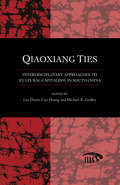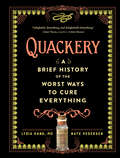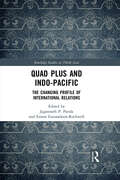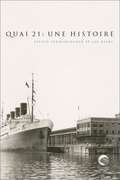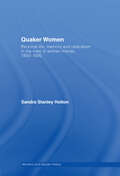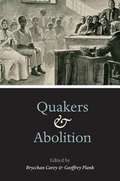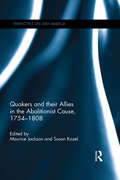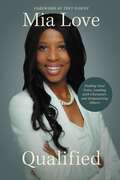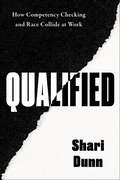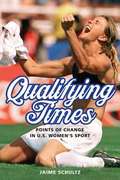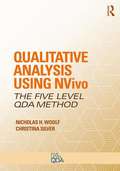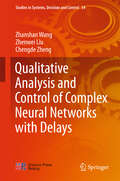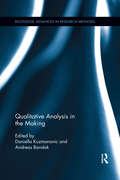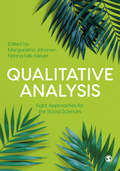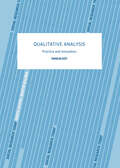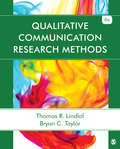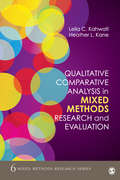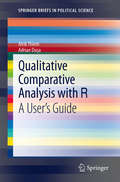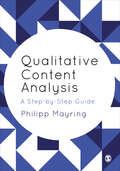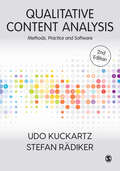- Table View
- List View
Qiaoxiang Ties
by DouwFirst Published in 1999. Routledge is an imprint of Taylor & Francis, an informa company.
Quackery: A Brief History of the Worst Ways to Cure Everything
by Lydia Kang Nate PedersenWhat won’t we try in our quest for perfect health, beauty, and the fountain of youth? Well, just imagine a time when doctors prescribed morphine for crying infants. When liquefied gold was touted as immortality in a glass. And when strychnine—yes, that strychnine, the one used in rat poison—was dosed like Viagra. Looking back with fascination, horror, and not a little dash of dark, knowing humor, Quackery recounts the lively, at times unbelievable, history of medical misfires and malpractices. Ranging from the merely weird to the outright dangerous, here are dozens of outlandish, morbidly hilarious “treatments”—conceived by doctors and scientists, by spiritualists and snake oil salesmen (yes, they literally tried to sell snake oil)—that were predicated on a range of cluelessness, trial and error, and straight-up scams. With vintage illustrations, photographs, and advertisements throughout, Quackery seamlessly combines macabre humor with science and storytelling to reveal an important and disturbing side of the ever-evolving field of medicine.
Quad Plus and Indo-Pacific: The Changing Profile of International Relations (Routledge Studies on Think Asia)
by Jagannath P. PandaThis book explores how the Quad Plus mechanism is set to reshape the global multilateral economic and security co-operations between Quad partner countries and the rest of the world. With the Quad partners – Australia, India, Japan and the United States – seeing deteriorating ties with China, the book provides a holistic understanding of the reasons why Quad Plus matters and what it means for the post-COVID Indo-Pacific and Asian order. It goes beyond the existing literature of the global Post-COVID reality and examines how Quad Plus can grow and find synergy with national and multilateral Indo-Pacific initiatives. The chapters analyze the mechanism’s uncharacteristic yet active approach of including countries like South Korea, Israel, Brazil, New Zealand and ASEAN/Vietnam for their successful handling of the pandemic crisis, thereby reshaping the new world’s geopolitical vision. A unique study focused solely on the intricacies and the broader dialogue of the ‘Quad Plus’ narrative, the book caters to strategic audiences as well as academics researching International Relations, Politics, and Indo-Pacific and Asian Studies.
Quai 21: Une histoire (Mercure #5)
by Jan Raska Steven SchwinghamerEntre 1928 et 1971, près d’un million de personnes ont immigré par bateau au Canada, débarquant au Quai 21 d’Halifax, en Nouvelle-Écosse. Quai 21 : Une histoire (également disponible en anglais : Pier 21: A History) porte sur l’histoire de cet important centre d’immigration maritime canadien durant ses années d’activité et, ultérieurement, en tant que site de commémoration publique. Entre 1928 et 1971, presque un million d’immigrants sont arrivés par bateau au Canada, plus précisément au Quai 21, situé à Halifax en Nouvelle-Écosse. Durant toute cette période, le Quai 21 fut une des principales « portes d’entrée du Canada»; ce fut aussi le point de débarquement de presque 400 000 soldats canadiens qui rentraient au pays après avoir effectué leur service militaire en Europe durant la Seconde Guerre mondiale. Dans la période de l’immédiat après-guerre, le Quai 21 est devenu la porte d’entrée maritime la plus active au Canada. Aujourd’hui encore, de nombreux Canadiens entretiennent des liens particuliers avec le Quai 21, et ce, à travers leurs antécédents familiaux ou les récits d’arrivée de leurs parents sur le site du Quai 21. Depuis 1998, les chercheurs du Centre d’interprétation du Quai 21 et du Musée canadien de l’immigration ont mené de très nombreuses entrevues, examiné d’innombrables documents d’archives, compilé des récits écrits par des immigrants et acquis des photographies, des documents et d’autres objets emblématiques de l’histoire du Quai 21. Richement illustré, ce livre est le produit de ce long et patient travail de collecte. Il révèle l’histoire de cet immense hangar maritime canadien durant ses années d’activité et, ultérieurement, en tant que lieu historique national, musée et site mémoriel ouvert au grand public.
Quaker Women: Personal Life, Memory and Radicalism in the Lives of Women Friends, 1780–1930 (Women's and Gender History)
by Sandra Stanley HoltonOne nineteenth-century commentator noted the ‘public’ character of Quaker women as signalling a new era in female history. This study examines such claims through the story of middle-class women Friends from among the kinship circle created by the marriage in 1839 of Elizabeth Priestman and the future radical Quaker statesman, John Bright. The lives discussed here cover a period from the late eighteenth to the early twentieth centuries, and include several women Friends active in radical politics and the women’s movement, in the service of which they were able to mobilise extensive national and international networks. They also created and preserved a substantial archive of private papers, comprising letters and diaries full of humour and darkness, the spiritual and the mundane, family confidences and public debate, the daily round and affairs of state. The discovery of such a collection makes it possible to examine the relationship between the personal and public lives of these women Friends, explored through a number of topics including the nature of Quaker domestic and church cultures; the significance of kinship and church membership for the building of extensive Quaker networks; the relationship between Quaker religious values and women’s participation in civil society and radical politics and the women’s rights movement. There are also fresh perspectives on the political career of John Bright, provided by his fond but frank women kin. This new study is a must read for all those interested in the history of women, religion and politics.
Quakers and Abolition
by Brycchan Carey Geoffrey PlankThis collection of fifteen insightful essays examines the complexity and diversity of Quaker antislavery attitudes across three centuries, from 1658 to 1890. Contributors from a range of disciplines, nations, and faith backgrounds show Quaker's beliefs to be far from monolithic. They often disagreed with one another and the larger antislavery movement about the morality of slaveholding and the best approach to abolition. Not surprisingly, contributors explain, this complicated and evolving antislavery sensibility left behind an equally complicated legacy. While Quaker antislavery was a powerful contemporary influence in both the United States and Europe, present-day scholars pay little substantive attention to the subject. This volume faithfully seeks to correct that oversight, offering accessible yet provocative new insights on a key chapter of religious, political, and cultural history. Contributors include Dee E. Andrews, Kristen Block, Brycchan Carey, Christopher Densmore, Andrew Diemer, J. William Frost, Thomas D. Hamm, Nancy A. Hewitt, Maurice Jackson, Anna Vaughan Kett, Emma Jones Lapsansky-Werner, Gary B. Nash, Geoffrey Plank, Ellen M. Ross, Marie-Jeanne Rossignol, James Emmett Ryan, and James Walvin.
Quakers and Their Allies in the Abolitionist Cause, 1754-1808 (Perspectives on Early America #1)
by Susan Kozel Maurice JacksonThis volume explores the significant connections between the Quaker community and the abolitionist cause in America. The case studies that make up the collection mainly focus on the greater Philadelphia area, a hotbed of the abolitionist movement and the location of the first American abolition society founded in 1775. Despite the importance of Quakers to the abolitionist movement, their significance has been largely overlooked in the existing historiography. These studies will be of interest to scholars of slavery and abolition, religious history, Atlantic studies and American social and political history.
Qualified: Finding Your Voice, Leading with Character, and Empowering Others
by Mia LoveThis memoir from the first Black Republican congresswoman in America shows readers how to own their stories, find their voices, and lead with character as they empower others to do the same. For so long, women—and Black women in particular—have been taught that they must have a stellar background, the highest degree of education, and the strongest resumé imaginable to earn their place in a society historically dominated by white men. As a result, women have found themselves plagued with anxiety and self-doubt and have felt constricted by this limiting belief of qualification by achievement and the necessity of sporting a flawless track record. These false assumptions have discouraged women from pursuing positions of power and influence for the betterment of their communities, leading to underrepresentation in our institutions and the tragedy of wasted potential. But it doesn&’t have to be this way. Mia Love has devoted her entire life to defeating illusive boundaries and redefining the meaning of &“qualified.&” The daughter of immigrant parents who sacrificed everything to embrace the American Dream, Love learned that she had something unique and valuable that she could give back to her country—her voice. And now she wants to empower others to do the same. For years, Love faced intense scrutiny and fielded questions regarding her political party affiliation, her desire to run for office, and her commitment to championing conservative values. In Qualified, Love explains her answers to these questions by taking readers through her journey from election to her local city council, leading as mayor of Saratoga Springs, and making history in the U.S. House of Representatives serving Utah&’s 4th Congressional District from 2015–2019. Her story showcases how we can stay true to our integrity, fearlessly voice our values despite fervent opposition, and begin again after every failure and setback.
Qualified: How Competency Checking and Race Collide at Work
by Shari DunnA groundbreaking work challenging the false narrative that diversity equals a lack of qualifications by uncovering the impact of “competency checking,” a practice that unjustly scrutinizes Black people and other people of color, forcing them to repeatedly prove their worth, intelligence, and even their right to be in the workplace.The advancement of Black and other people of color in the workplace is under attack as there is a turn away from the promise of the "racial reconciliation" of 2020. This period saw Black talent rise in the workplace from DEI managers to CEOs to junior-level hires. Yet, the post-2020 workplace is seeing an alarming retreat from creating workplaces and leadership that reflect the nation’s diversity.That retreat is characterized by underemployment, cracked glass cliffs, toxic work environments, and claims of “empty pipelines.” More concerning, Black professionals and other people of color often face greater scrutiny than their peers regarding job applications, work experience, and qualifications to even be considered for employment or advancement. And that scrutiny has a name: Competency Checking.When it comes to hiring Black talent, the pipeline isn’t broken; rather, it is the assumptions we make about who is competent and qualified. In Qualified, award-winning executive and journalist Shari Dunn combines deep research with enlightening interviews and anecdotes from across the broad spectrum of her career to uncover the history of Competency Checking, how it manifests in the workplace, and what can be done to change it. Competency checking, Dunn argues, continues to be practiced consciously and unconsciously and is the key reason why Black people and other people of color are underrepresented in so many industries and why there continues to be a revolving door of Black talent even after the hiring surges of 2020.
Qualifying Times: Points of Change in U.S. Women's Sport
by Jaime SchultzThis perceptive, lively study explores U.S. women's sport through historical "points of change": particular products or trends that dramatically influenced both women's participation in sport and cultural responses to women athletes. Beginning with the seemingly innocent ponytail, the subject of the Introduction, scholar Jaime Schultz challenges the reader to look at the historical and sociological significance of now-common items such as sports bras and tampons and ideas such as sex testing and competitive cheerleading. Tennis wear, tampons, and sports bras all facilitated women's participation in physical culture, while physical educators, the aesthetic fitness movement, and Title IX encouraged women to challenge (or confront) policy, financial, and cultural obstacles. While some of these points of change increased women's physical freedom and sporting participation, they also posed challenges. Tampons encouraged menstrual shame, sex testing (a tool never used with male athletes) perpetuated narrowly-defined cultural norms of femininity, and the late-twentieth-century aesthetic fitness movement fed into an unrealistic beauty ideal. Ultimately, Schultz finds that U.S. women's sport has progressed significantly but ambivalently. Although participation in sports is no longer uncommon for girls and women, Schultz argues that these "points of change" have contributed to a complex matrix of gender differentiation that marks the female athletic body as different than--as less than--the male body, despite the advantages it may confer.
Qualitative Analysis Using Nvivo: The Five-Level QDA® Method (Developing Qualitative Inquiry)
by Christina Silver Nicholas H. WoolfThis long, long labor of love would have never reached fruition without the enthusiastic support of many people. Jan Morse believed in the project when it was still a germinating seed, and it would not have happened without her encouragement. Trena Paulus stands out for critiquing early drafts, asking if she could test the Five- Level QDA method at the University of Georgia and inviting us to join her and Elizabeth Pope in their research of the use of the method.
Qualitative Analysis and Control of Complex Neural Networks with Delays
by Zhanshan Wang Zhenwei Liu Chengde ZhengThis book focuses on the stability of the dynamical neural system, synchronization of the coupling neural system and their applications in automation control and electrical engineering. The redefined concept of stability, synchronization and consensus are adopted to provide a better explanation of the complex neural network. Researchers in the fields of dynamical systems, computer science, electrical engineering and mathematics will benefit from the discussions on complex systems. The book will also help readers to better understand the theory behind the control technique and its design.
Qualitative Analysis in the Making (Routledge Advances in Research Methods #11)
by Daniella Kuzmanovic Andreas BandakHow do scholars transform qualitative data into analysis? What does making analysis imply? What happens in the space in-between data and finalized analysis is notoriously difficult to talk about. In other parts of the research process, scholars and students are aided by method books that describe the technicalities of generating, processing and sorting through data, handbooks that teach academic writing, and scholarly works that offer meta-level, theoretical perspectives. Yet the path from qualitative data to analysis remains ‘a black box.’ Qualitative Analysis in the Making ventures into this black box. The volume provides a means of speaking about how analyses emerge in the Humanities. Contributors from disciplines such as anthropology, history, and sociology of religion all employ an analytical double take. They revisit one of their analyses, analyzing how this particular analysis came into being. Such analyses of an analysis are neither confessions nor step-by-step recounts of what happened. Rather, the volume argues that speaking of the space in-between requires analytical displacement, and the employment of fresh analytical takes. This approach contributes to demystifying the path from qualitative data to finalized analysis. It invites novel epistemological reflections among scholars, and assists students in improving their analytical skills.
Qualitative Analysis: Eight Approaches for the Social Sciences
by Nanna Mik-Meyer Margaretha JärvinenIntroducing eight analytical approaches that are key to successful social science research, this book helps you get to grips with theory and apply it to qualitative analysis. With two &‘matched chapters&’ dedicated to each approach, it provides a balance between theory and analytical method. The first chapter grounds the approach in theory and the second uses real-world examples to show how to conduct your own analysis using the approach. Drawing on the contributing authors&’ wealth of experience, the book: · Highlights how analysis relates to the entire research process and helps you position your analysis within the larger context of your research · Provides a strong, theoretical foundation for building good qualitative analysis · Guides you through translating theory into real-world practice in your own research Detailed, clear and accessible, this book is perfect for students who want to understand the theory behind qualitative analysis before conducting their own research, or develop their understanding of specific approaches.
Qualitative Analysis: Eight Approaches for the Social Sciences
by Nanna Mik-Meyer Margaretha JärvinenIntroducing eight analytical approaches that are key to successful social science research, this book helps you get to grips with theory and apply it to qualitative analysis. With two &‘matched chapters&’ dedicated to each approach, it provides a balance between theory and analytical method. The first chapter grounds the approach in theory and the second uses real-world examples to show how to conduct your own analysis using the approach. Drawing on the contributing authors&’ wealth of experience, the book: · Highlights how analysis relates to the entire research process and helps you position your analysis within the larger context of your research · Provides a strong, theoretical foundation for building good qualitative analysis · Guides you through translating theory into real-world practice in your own research Detailed, clear and accessible, this book is perfect for students who want to understand the theory behind qualitative analysis before conducting their own research, or develop their understanding of specific approaches.
Qualitative Analysis: Practice And Innovation
by Douglas EzzyOffering a detailed introduction to the practice of data analysis, this book is both user-friendly and theoretically grounded. Drawing on his extensive experience of qualitative research, Douglas Ezzy reviews approaches to data analysis in established research traditions including ethnography, phenomenology and symbolic interactionism, alongside the newer approaches informed by cultural studies and feminism. He explains the difference between inductive, deductive and abductive theory building, provides a guide to computer-assisted analysis and outlines techniques such as journal writing, team meetings and participant reviews.This text is one of the first to treat computer assisted data analysis as an integral part of qualitative research. Exceptionally well written, this is a valuable reference for research students and professional researchers in the social sciences and health.
Qualitative Communication Research Methods (Fourth Edition)
by Thomas R. Lindlof Bryan C. TaylorQualitative Communication Research Methods, Fourth Edition introduces you to qualitative research in speech and mass communication. Award-winning scholars and authors Thomas R. Lindlof and Bryan C. Taylor guide you through every step of the qualitative process, from developing research topics and questions through writing a final report. You are given numerous examples of work in the field to illustrate how studies are designed, carried out, written, evaluated, and related to theory. In addition to covering the theories and methods currently used in qualitative communication research, the authors also discuss important trends influencing the future of that research, helping you make informed judgments about the significance and consequences of recent trends.
Qualitative Comparative Analysis Using R: A Beginner's Guide (Methods for Social Inquiry)
by Carsten Q. Schneider Eva Thomann Ioana-Elena OanaA comprehensive introduction and teaching resource for state-of-the-art Qualitative Comparative Analysis (QCA) using R software. This guide facilitates the efficient teaching, independent learning, and use of QCA with the best available software, reducing the time and effort required when encountering not just the logic of a new method, but also new software. With its applied and practical focus, the book offers a genuinely simple and intuitive resource for implementing the most complete protocol of QCA. To make the lives of students, teachers, researchers, and practitioners as easy as possible, the book includes learning goals, core points, empirical examples, and tips for good practices. The freely available online material provides a rich body of additional resources to aid users in their learning process. Beyond performing core analyses with the R package QCA, the book also facilitates a close integration with the R package SetMethods allowing for a host of additional protocols for building a more solid and well-rounded QCA.
Qualitative Comparative Analysis in Mixed Methods Research and Evaluation (Mixed Methods Research Series #6)
by Leila Kahwati Heather KaneQualitative Comparative Analysis in Mixed Methods Research and Evaluation provides a user-friendly introduction for using Qualitative Comparative Analysis (QCA) as part of a mixed methods approach to research and evaluation. Offering practical, in-depth, and applied guidance for this unique analytic technique that is not provided in any current mixed methods textbook, the chapters of this guide skillfully build upon one another to walk researchers through the steps of QCA in logical order. To enhance and further reinforce learning, authors Leila C. Kahwati and Heather L. Kane provide supportive learning objectives, summaries, and exercises, as well as author-created datasets for use in R via the companion site. Qualitative Comparative Analysis in Mixed Methods Research and Evaluation is Volume 6 in SAGE’s Mixed Methods Research Series. To learn more about each text in the series, please visit sagepub.com/mmrs.
Qualitative Comparative Analysis in Mixed Methods Research and Evaluation (Mixed Methods Research Series #6)
by Leila Kahwati Heather KaneQualitative Comparative Analysis in Mixed Methods Research and Evaluation provides a user-friendly introduction for using Qualitative Comparative Analysis (QCA) as part of a mixed methods approach to research and evaluation. Offering practical, in-depth, and applied guidance for this unique analytic technique that is not provided in any current mixed methods textbook, the chapters of this guide skillfully build upon one another to walk researchers through the steps of QCA in logical order. To enhance and further reinforce learning, authors Leila C. Kahwati and Heather L. Kane provide supportive learning objectives, summaries, and exercises, as well as author-created datasets for use in R via the companion site. Qualitative Comparative Analysis in Mixed Methods Research and Evaluation is Volume 6 in SAGE’s Mixed Methods Research Series. To learn more about each text in the series, please visit sagepub.com/mmrs.
Qualitative Comparative Analysis with R
by Adrian Dusa Alrik ThiemSocial science theory often builds on sets and their relations. Correlation-based methods of scientific enquiry, however, use linear algebra and are unsuited to analyzing set relations. The development of Qualitative Comparative Analysis (QCA) by Charles Ragin has given social scientists a formal tool for identifying set-theoretic connections based on Boolean algebra. As a result, interest in this method has markedly risen among social scientists in recent years. This book offers the first complete introduction on how to perform QCA in the R software environment for statistical computing and graphics with the QCA package. Developed as a comprehensive solution, QCA provides an unprecedented scope of functionality for analyzing crisp, multi-value and fuzzy sets. The reader is not required to have knowledge of R, but the book assumes an understanding of the fundamentals of QCA. Using examples from published work, the authors demonstrate how to make the most of QCA's wide-ranging capabilities for the reader's own purposes. Although mainly written for political scientists, this book is also of interest to scholars from other disciplines in the social sciences such as sociology, business, management, organization, anthropology, education and health.
Qualitative Content Analysis: A Step-by-Step Guide
by Philipp MayringIn eight clear-cut steps, this book provides a systematic introduction to qualitative content analysis and how you can use it in each stage of your research project, no matter the type or amount of data. Developed by a leading expert in the field and based on years of teaching experience, this book offers an essential framework for interpreting qualitative data for any social sciences student or researcher. To support you in choosing the best approach for your research, this book includes: · Examples of how QCA can be applied to various research processes · An introduction to text analysis and its different approaches · Discussions of how to use QCA software to benefit your research · An online how-to manual to help you get the most out of QCAmap software. It also introduces the process of scientific research, and integrates qualitative and quantitative analysis into the step-by-step approach.
Qualitative Content Analysis: A Step-by-Step Guide
by Philipp MayringIn eight clear-cut steps, this book provides a systematic introduction to qualitative content analysis and how you can use it in each stage of your research project, no matter the type or amount of data. Developed by a leading expert in the field and based on years of teaching experience, this book offers an essential framework for interpreting qualitative data for any social sciences student or researcher. To support you in choosing the best approach for your research, this book includes: · Examples of how QCA can be applied to various research processes · An introduction to text analysis and its different approaches · Discussions of how to use QCA software to benefit your research · An online how-to manual to help you get the most out of QCAmap software. It also introduces the process of scientific research, and integrates qualitative and quantitative analysis into the step-by-step approach.
Qualitative Content Analysis: Methods, Practice and Software
by Udo Kuckartz Stefan RadikerAre you working with qualitative data but unsure how to approach your analysis? This hands-on guide to qualitative content analysis from two internationally renowned experts provides you with a clear strategy for analysing your data, whether you are working with social media content, field notes, images, narratives or focus group data. Using qualitative interviews as an example, the book provides a clear structure for approaching your analysis that can be adapted for your research project. Explaining how qualitative content analysis differs from quantitative methods, the book provides you with: •a solid understanding of the principles behind QCA •a step-by-step guide to three types of QCA •guidance on how you can use software to enhance your analysis.
Qualitative Content Analysis: Methods, Practice and Software
by Udo Kuckartz Stefan RadikerAre you working with qualitative data but unsure how to approach your analysis? This hands-on guide to qualitative content analysis from two internationally renowned experts provides you with a clear strategy for analysing your data, whether you are working with social media content, field notes, images, narratives or focus group data. Using qualitative interviews as an example, the book provides a clear structure for approaching your analysis that can be adapted for your research project. Explaining how qualitative content analysis differs from quantitative methods, the book provides you with: •a solid understanding of the principles behind QCA •a step-by-step guide to three types of QCA •guidance on how you can use software to enhance your analysis.
